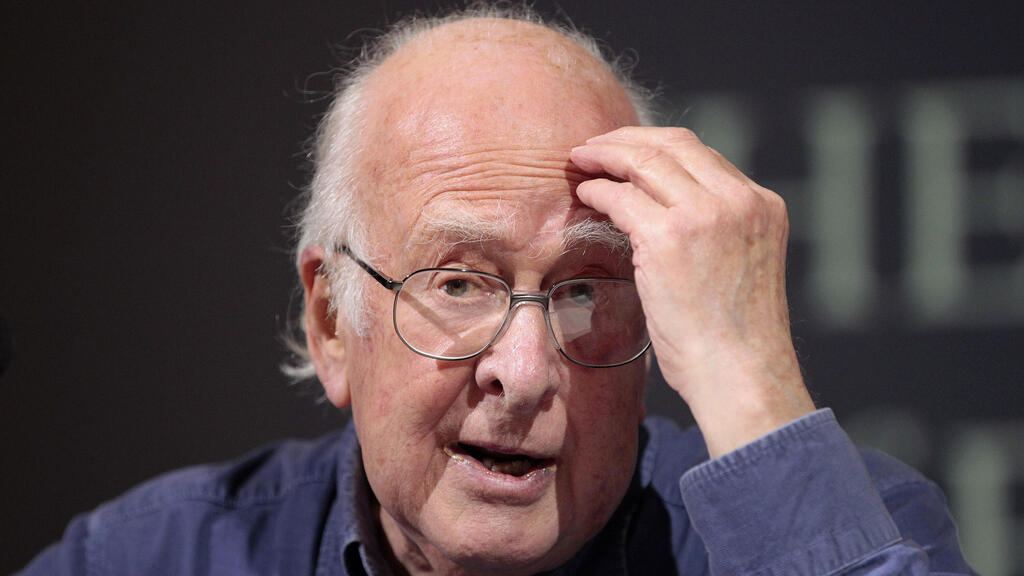Twelve years ago, on July 4th, 2012, masses stormed the entrance of the lecture hall at the European Center for Nuclear Research (CERN) in Geneva. The excitement was comparable to that felt before a once-in-a-lifetime rock concert, by the Rolling Stones at the very least.
This time, however, it was an announcement by CERN laboratories, that their two biggest experiments, the ATLAS and CMS detectors, had found evidence of the Higgs boson's existence, also called “the God particle,” after years of searching for it by the Large Hadron Collider (LHC).
6 View gallery
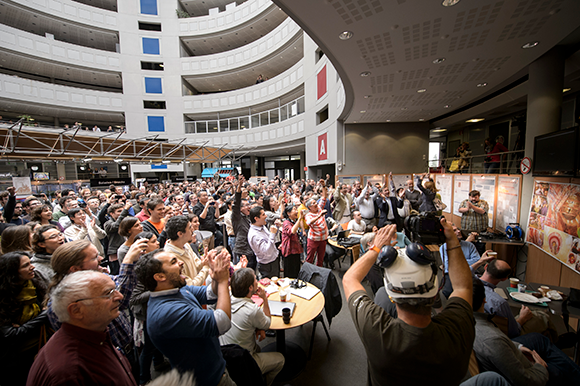

An atmosphere akin to that of a once-in-a-lifetime rock concert. The announcement of the discovery of the Higgs boson in CERN, 2012
(photo: CERN)
As the head of the research group working on ATLAS, I quickly passed through security and entered the hall. We had no idea whether CERN’s Director-General, Rolf-Dieter Heuer, would announce the discovery of the Higgs boson or just report on strong evidence of its existence, as he had done six months prior when we started noticing the signs.
While awaiting the event's start, we saw the experiment heads who discovered the particle, referred to at CERN as “spokespersons,” enter the hall. Joe Incandela, spokesperson for CMS, was followed by Fabiola Gianotti, ATLAS spokesperson and current Director-General of CERN. Suddenly, we saw Peter Higgs and François Englert enter the hall. They approached each other and shook hands.
It was their first meeting, and they had no idea that about one year later, they would meet again in Stockholm to receive the Nobel Prize in Physics for the theoretical prediction of the mechanism that grants mass to particles through the Higgs field.
Our excitement as Higgs hunters reached an all-time high, as the invitation of Englert and Higgs to the event had one clear meaning: CERN was about to announce the discovery of the Higgs boson. Not just evidence of its existence, but a discovery. And indeed, Heuer concluded his words with, "As a layman I would say: 'I think we have it'. We have a discovery. We have found a new particle, consistent with the predictions of the Higgs boson”.
A meeting by mail
Peter Higgs died this month, at the age of ninety-four. Higgs was portrayed in The Independent as a mild-mannered grandfather who, since his retirement from the University of Edinburgh in 2006, spent his time taking care of his grandchildren, reading, listening to classical music, and hiking in the beautiful mountains of Scotland.
I can personally attest to this. In 2009, as part of the popular science lectures I have been giving around the world for many years, I sent an email to Higgs and asked to meet and discuss the wonderful story of the Higgs boson with him.
He had written a magnificent article titled: “My Life as a Boson”, where he describes the history and the people involved in predicting the existence of the particle that bears his name. The story was fascinating and I wanted to hear it from Higgs himself. Many months passed before I received a reply from Alan Walker, a physicist and self-proclaimed scientific secretary of Peter Higgs.
Walker wrote back that Higgs did not use email; he was old school. However, considering that I was a highly regarded Higgs hunter in the physics community, he offered that I give a seminar at the University of Edinburgh. He added that Higgs was interested, would attend the seminar, and later meet for a glass of beer to answer my questions. He even offered to fund my trip. He even offered to fund my trip.
At the end of February 2009, I was very excited when I arrived at the university guesthouse. The wintry weather made me wish for the night to pass quickly so that I could finally meet Higgs the next day. In my room, I had a cup of English tea waiting by the telephone, which had a blinking light. It was a message from Allen Walker.
He welcomed me and apologetically added that Higgs would not attend the seminar as he had to look after his grandchildren. That was it. The next day, I gave the seminar, and later Walker took me on a pub tour in Edinburgh. He said that Higgs frequented these pubs and had his lunches there, and we might meet him.
6 View gallery
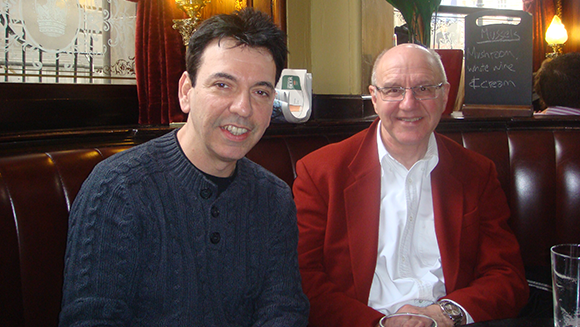

Instead of discussing bosons with Higgs, a pub tour with his secretary. Eilam Gross with Alan Walker, Higgs's scientific secretary, at a pub in Edinburgh
(Photo: Eilam Gross)
I left Walker a list of questions and a gift I bought for Higgs, the graphic novel version of "Waltz With Bashir." I thought it was an appropriate gift for someone who refused to accept the Wolf Prize in 2004 in protest of what he called the “Israeli occupation in the West Bank.” I returned to Israel disappointed.
Nearly a year passed, and I had almost forgotten about the event when, when in my incoming mailbox at the Weizmann Institute, I found a letter, like in the old days… paper sheets in an envelope addressed to me, and the sender was none other than Peter Higgs from Downey Street in Edinburgh.
The letter included his gratitude for "Waltz With Bashir" and detailed answers to my questions. All in almost illegible handwriting, written with pen on old stationery paper. Every cloud has its silver lining. I received Peter Higgs’s life as a Higgs boson directly into my mailbox.
Symmetry and its breaking
In his modesty, Higgs acknowledges seven contributions to the discovery in his letter, starting from Lev Landau in 1960 to Tom Kibble in 1964. The narrative unfolds with Richard Feynman and many others developing the photon theory, or what is known as quantum electrodynamics (QED).
In this theory, symmetry considerations gave rise to the concept of the electric force transmitted by force-carrying particles, the massless photons. Physicists fell in love with the concept of symmetry and tried to apply it to theories of other natural forces. Symmetry considerations necessitate that particles in nature be massless, particularly force-carrying particles, yet mass is an undeniable reality.
6 View gallery
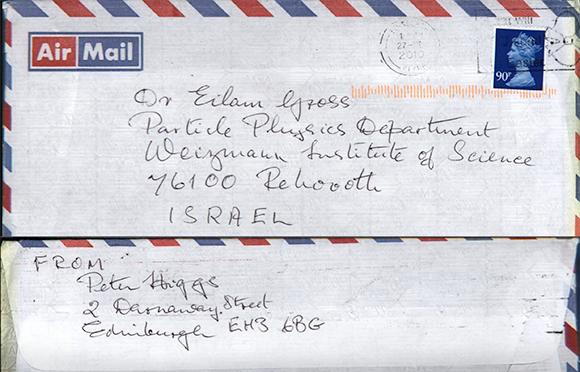

I received his life directly into my mailbox. The envelope that contained Peter Higgs’s letter to Eilam Gross
(Photo: Eilam Gross)
Without mass, the Sun would not generate energy through nuclear fusion, there would be no atoms and no chemistry as we know it. Mass is essential to our existence, and we would not be here without it. Symmetry embodies beauty, and we want the physics that describes our world to be shrouded in beauty, but what do we do when it does not fit?
One of the proposed solutions was the concept of “spontaneous symmetry breaking.” In this scenario, the physical system possesses symmetry, yet it is disrupted by the particles within it. Consequently, while the system maintains its symmetry, the particles "perceive" no symmetry; it remains concealed from them. This can be likened to an upside-down broom balanced on the tip of a finger, which then topples in a specific direction without it being possible to predict in which direction it will fall.
Before it falls, the broom exhibits complete circular symmetry and could topple in any direction. However, once it has fallen, gravity, the force responsible for its descent, retains perfect symmetry, but the broom itself does not.
Japanese-American physicist Yoshihiro Nambu proposed in 1960 to implement spontaneous symmetry breaking to grant mass to force particles. Force particles are required to have mass to describe short-range forces, like the strong nuclear force or the weak nuclear force.
He would later receive the Nobel Prize in Physics for this. The British physicist Jeffrey Goldstone later demonstrated that spontaneous symmetry breaking requires the existence of massless particles, which were named after him, “Goldstone bosons.” Experiments were conducted to search for these particles, but to no avail.
6 View gallery
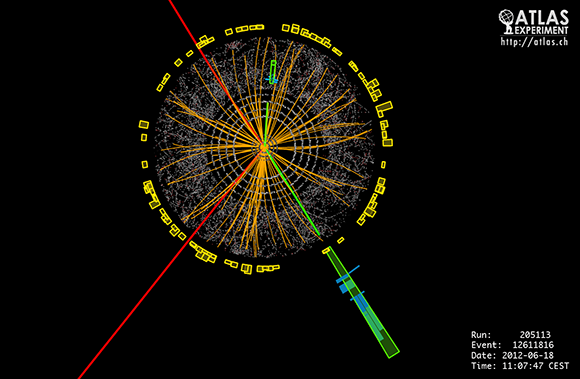

Evidence of spontaneous symmetry breaking. Findings by the ATLAS detector that enabled the discovery of the Higgs boson
(Photo: CERN)
In 1964, Higgs published a three page article where he demonstrated how to avoid the massless Goldstone bosons. Shortly after, he presented how it is possible to grant mass to a force boson and thus allow force to be active at a short range, when a massless force boson, like a photon, “eats” the massless Goldstone particle and thus receives mass, like the W boson, which mediates radioactive radiation.
The short article, only one and a half pages, was sent to the same journal and was rejected. Higgs was shocked, not understanding how his first article was accepted and the second one rejected while it is, in fact, a sequel to it.
He took a deep breath and tried to read and understand what was wrong with the rejected paper. Then he added a paragraph at the end, where he stated: “It is worth noting that an essential feature of the type of theory which has been described in this note is the prediction of incomplete multiplets of scalar and vector bosons.” And so the Higgs boson was born.
Higgs sent the article with the addition to another journal that accepted it with one reservation: one month prior, an article by Englert and Robert Brout was published in this journal, and he was asked to reference it.
It was later found that the reviewer who read and accepted his article was none other than Nambu. In his letter to me, Higgs says (in simplified terms): “In the first article, I demonstrated how to avoid massless Goldstone particles. Englert and Brout demonstrated how you can turn massless Goldstone bosons to particles with mass, but did not relate to the particles with mass that are left. In the second article, I demonstrated how you can simply obtain bosons with mass from the Goldstone boson, but I have specifically indicated the existence of another particle with mass.”
Higgs credits many physicists but explicitly states that he is the only one who predicted the existence of the particle that would later be known as the Higgs boson.
6 View gallery
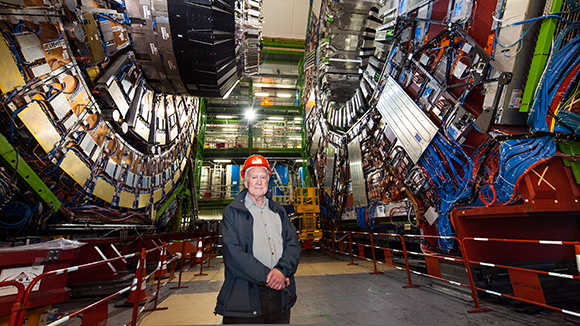

The only one to have predicted the existence of the additional scalar particle, which was later named after him. Peter Higgs at the ATLAS detector at CERN
(Photo: CERN)
A modest physicist
Immediately after the article barrage of 1964 about spontaneous symmetry breaking, particularly following Higgs' prediction of the particle, a race began among experimental physicists to hunt down the additional scalar particle. At Fermilab in Chicago, great efforts were made to find the particle, but without success.
Leon Lederman, the director of Fermilab and a Nobel Prize laureate in physics, frustrated by the lack of success, wrote a book about the search in 1993. According to him, he wanted to name the book “The Goddamn Particle”, but the publisher argued that the name would not sell books and suggested shortening it to “The God Particle,” thus giving birth to the nickname "The God Particle".
Scientists did not like this name, and Higgs himself strongly opposed it, being an atheist. Yet, the name carries a certain poetic justice, as without the Higgs boson, we would not exist. Higgs also disliked being the namesake of the particle and often referred to it as “the so-called Higgs boson.”
I eventually met Higgs briefly when I was invited to present the discovery of the boson during the ATLAS experiments at a symposium in Edinburgh. This was right after the discovery announcement and before the Nobel Prize in Physics was awarded to Higgs and Englert in 2013.
The award committee was desperately searching for Higgs to inform him of the decision prior to the official announcement, as customary. However, he had vanished, as if he did not want to hear the news. He was eventually informed only after the public announcement, by a neighbor he met on the street while walking home.
It is further told that the Nobel committee, which convened to select the winners of the Nobel Prize in Physics for 2013, debated intensely about the possibility of awarding the prize to ATLAS and CMS in addition to Higgs and Englert. Eventually, one committee member was quoted as saying they did not want 5,000 people claiming to be Nobel laureates. Therefore, the prize was awarded to Higgs and Englert, with the committee’s justification explicitly stating that it was awarded thanks to the discovery of the Higgs boson by CERN.
When Higgs was asked about his feelings following the discovery of the boson that carries his name, he said: “I’m happy it happened during my lifetime”. As a scientist who studies particles with lifetimes measured in fractions of a second, I realized that only a very modest physicist could give such an answer.
Eilam Gross is a professor in the Department of Particle Physics and Astrophysics at the Weizmann Institute of Science, and one of the leaders of the search after the Higgs boson in the ATLAS experiment at CERN.


